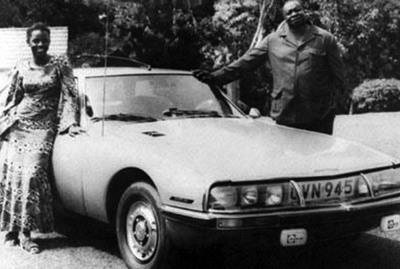This week marks the 38th anniversary of the National Resistance Movement (NRM) since it seized power, bringing an end to the previous government and liberating Uganda from past instabilities. The Liberation Day celebrations for 2024 are slated to take place in Jinja City, as confirmed by the organizers.
It is remembered that on January 26th, 1986, Gen Museveni, along with fellow revolutionaries, courageously stormed Kampala, marking a pivotal moment in Uganda’s history. Their united mission was to liberate Ugandans from the oppressive regimes that dominated the country at that time.
The triumph attained on that momentous day demanded over five years of persistent efforts from General Museveni and his fellow revolutionaries to overcome the diverse forces that had been terrorizing Uganda. The National Resistance Army, originating from FRONASA, actively participated in numerous struggles during this extended five-year period following the removal of Field Marshal Idi Amin Dada from power.
In the tapestry of remembrance, a timeless saying echoes: no dead hero truly dies, their legacy perpetually alive in the hearts and minds of those they touched. Their deeds, valor, and noble qualities weave into the fabric of history, a luminous thread guiding generations forward. Amidst the echoes of bravery and selflessness, the departed hero’s spirit endures, a testament that true heroism transcends mortal limits.
In alignment with this sentiment, departed warriors such as Major General Pecos Kutesa, Gen Aronda Nyakairima, Elly Tumwine, Sselwanga Lwanga, Fred Rwigyema and many others remain eternally ingrained in our collective memory. Their sacrifices for this country etch a profound mark, ensuring they are forever remembered and honored.
In the accounts shared by the fortunate revolutionaries who witnessed the victory and lived to experience the fruits of their sacrifices, tales of terror and unwavering courage emerge. This article, courtesy of Watchdog Uganda, presents a chronicle by the late Major General Pecos Kutesa from his book ‘Uganda’s Revolution 1979-1986-How I Saw It.’
Engaging in guerrilla warfare involves a series of events, ranging from the grim to the amusing. In his book, Major General Kutesa shares an amusing story about an abandoned state-of-the-art car left behind by former President Idi Amin that captivated the attention of many commanders. Despite their desire to claim and use or drive it, each attempt to make it move even an inch proved unsuccessful.
He recounts that in the pursuit against Amin’s soldiers, Kutesa’s company, under the command of Gen Saleh, ventured into Pakwach. Crossing the bridge, they entered West Nile after navigating Lake Albert using a ferry.
They pressed on with their journey until they reached Arua town in the evening. The town pulsated with activity, with an abundance of Tanzanian troops outnumbering the civilians. The Tanzanian forces took the lead in securing the borders with both Zaire (now DRC) and Sudan. Once again, Kutesa’s group was entrusted with the responsibility of safeguarding the town and its outskirts.
“Our group, now calling itself “The Red Army” at the instigation of Chefe Salim Saleh, covered the town. My “coy” occupied Tanganyika village. Arua had villages named after countries neighbouring Uganda. There was Kenya, Tanzania, Zambia, etc…” he narrates.
He goes on to mention that his company was the initial one to take possession of Idi Amin’s house, discovering it entirely vacant. Yet, as the saying goes, “a rich or old man’s home can never be completely empty.” Kutesa came across a bundle of five thousand shillings in five-shilling notes.
“But the main prize was the Citroen Maserati. This is the car Idi Amin drove during the OAU conference in Uganda in 1975 when, owing to public demand, he married his wife Sarah “once more again for the second time”, as he so aptly put it….”
As the company commander, Kutesa immediately commandeered the former head of state’s prize car. “However, apart from offering me a very warm and comfortable bed, there was nothing more that its beauty could offer me. The car was computerized and the keys were not available…Those fancy cars have a bad habit of defying the common Ugandans limited knowledge of electronics.”
He narrates that the car had been parked and the body had settled down, almost touching the tarmac. Even when his whole company tried to push it, it just sat there unbothered!
“The few of us who had had more exposure to cars tried to open the bonnet but nobody could find the lever to pull or push. We looked at the beautiful car and it seemed to stare back at us. It seemed to be looking at us in contempt owing to our ignorance. Nobody could bring himself to vandalize such a masterpiece..” he narrates.
Despite its initial failure to move, luck smiled upon Kutesa when they managed to open the doors. For two days, it served as Kutesa’s makeshift camp bed. However, after this brief respite, his commander Saleh reclaimed it, and Kutesa had to vacate the car.
“On the third day Afande Saleh heard of the car. He came and claimed it as his own. I left it to him. However, he could not move it even an inch either, even when a Tata lorry was used to try to tow it. The chain used damaged the body of the car instead of moving it. The wheels were locked. I left the car with my boss Saleh and continued with my work.
He recounts that Saleh had possession of the car for approximately ten days. True to the saying, “what goes around comes around,” Salim Saleh eventually handed it over to the Tanzanian general, who, as the sector commander, asserted ownership. However, the Tanzanian general faced the same challenge — the car’s immobility. It remained in the same spot where Kutesa’s group discovered it until they departed Arua for reorganization in Kabamba.
However, despite its inability to move, when the Tanzanians were departing Uganda, they airlifted it to Tanzania. Nevertheless, even after reaching Tanzania, little was done with it, and ultimately, it was left abandoned.
“I forgot all about the car until we landed at Arusha International Airport in Tanzania on our way to Monduli for training, when I saw the same car among the junk looted cars which the Tanzanians had taken home. We were informed that the car had been airlifted and dumped at the airport. By the time we left Tanzania, the car was still parked there…”
The car remained stationary as Field Marshal Dada, its owner, had locked it, and no one succeeded in driving it. This circumstance preserved its glory as a presidential car.
The Citroen Maserati was a luxurious and remarkable car, often favored by the prominent figures of its time. In Africa, notable personalities who owned this prestigious vehicle included Gen Amin, who possessed seven of them, and Emperor Haile Selassie I of Ethiopia.
Do you have a story in your community or an opinion to share with us: Email us at editorial@watchdoguganda.com














